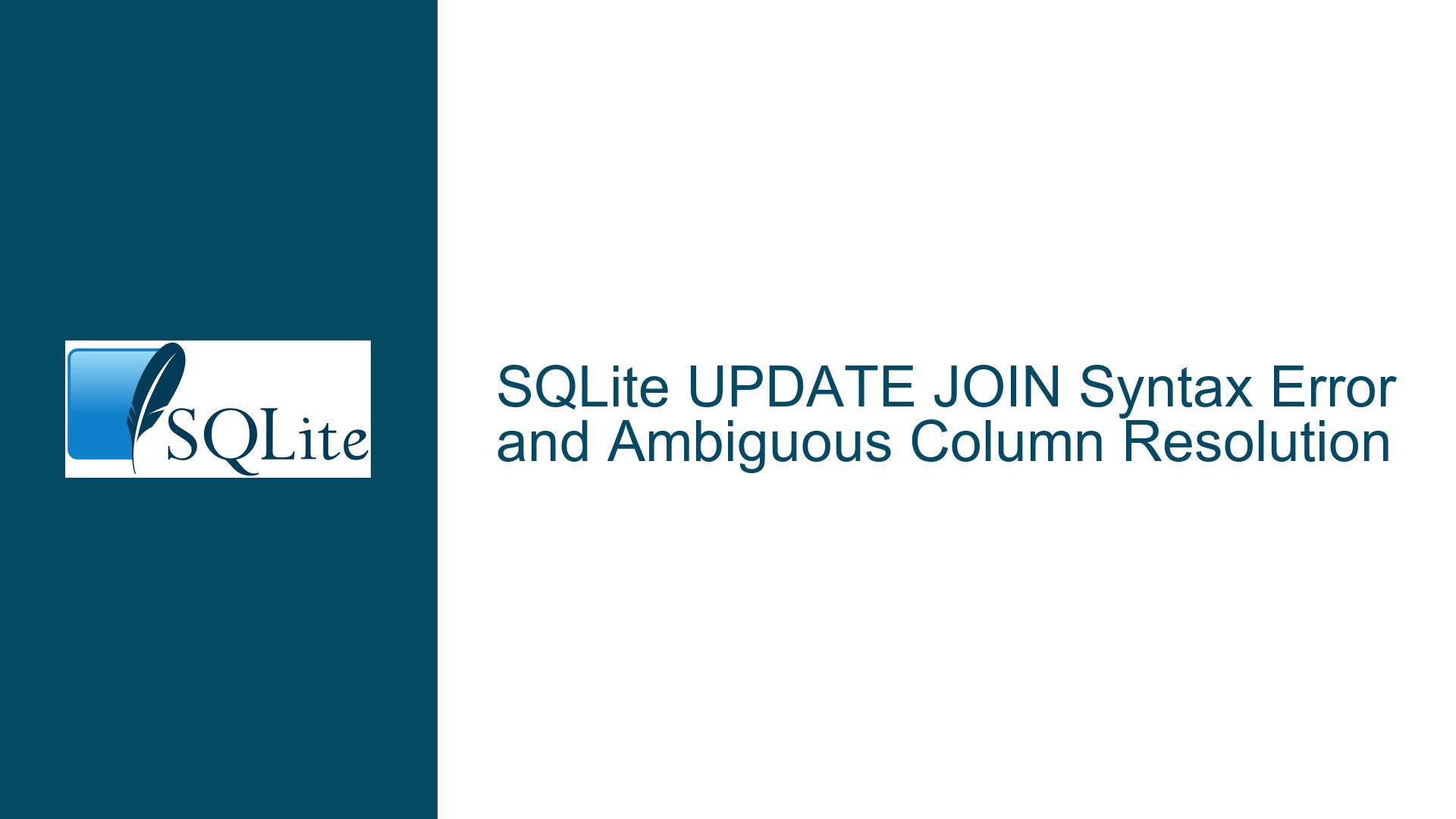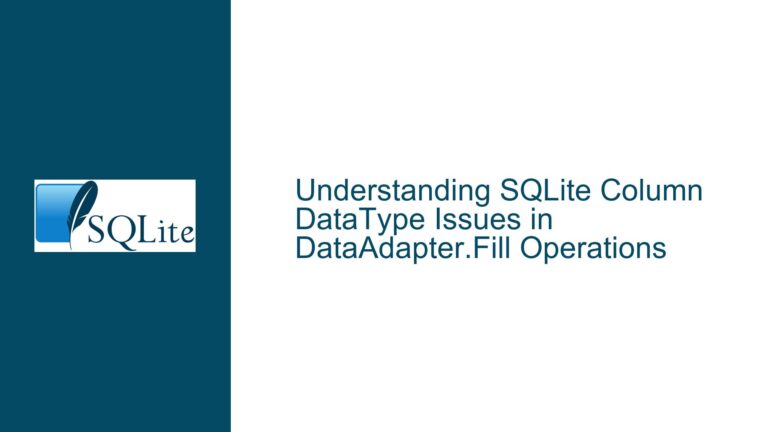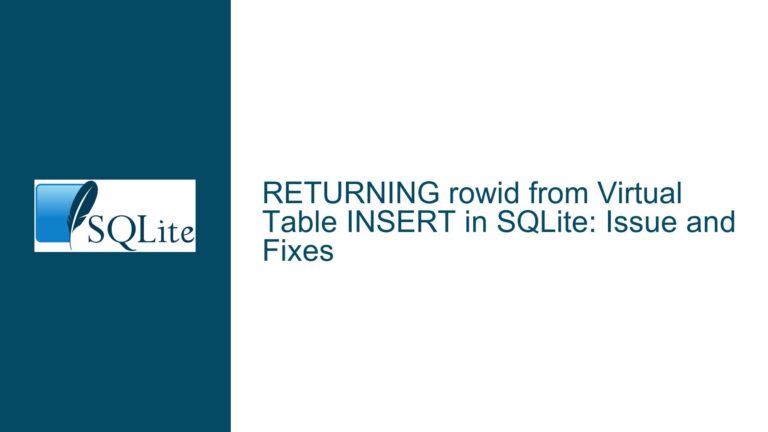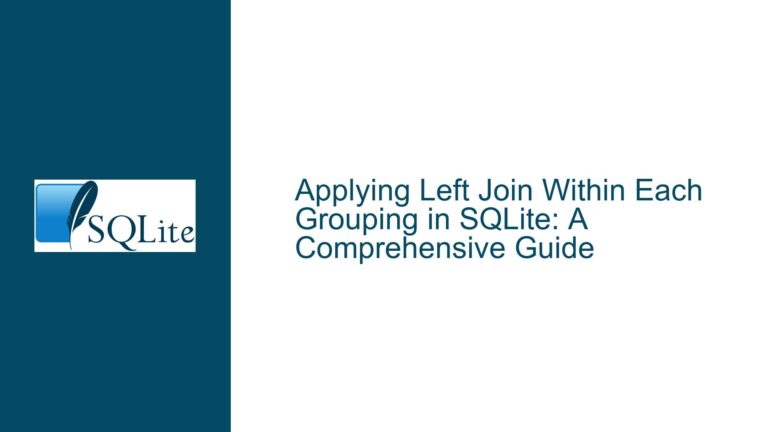SQLite UPDATE JOIN Syntax Error and Ambiguous Column Resolution
UPDATE INNER JOIN Syntax Error in SQLite
The core issue revolves around attempting to use an UPDATE statement with an INNER JOIN in SQLite, which results in a syntax error. This is a common stumbling block for users transitioning from other database systems like MS Access or SQL Server, where such constructs are supported. SQLite, however, does not natively support UPDATE statements combined with INNER JOIN. Instead, SQLite introduced the UPDATE FROM syntax in version 3.33.0, which provides a way to perform updates based on joins, albeit with a different syntax.
The error message Error: near "INNER": syntax error is a direct result of SQLite’s parser not recognizing the INNER JOIN clause within an UPDATE statement. This is because SQLite’s SQL dialect is more restrictive compared to other databases, and it adheres closely to the SQL standard while offering fewer extensions. The UPDATE FROM syntax, which is a non-standard extension borrowed from PostgreSQL, is the recommended approach for achieving similar functionality in SQLite.
Interrupted Write Operations Leading to Index Corruption
The confusion arises from the differences in SQL dialects between SQLite and other database systems. In MS Access and SQL Server, the UPDATE statement can directly incorporate INNER JOIN clauses, allowing for updates based on conditions that involve multiple tables. This is not the case in SQLite, where the UPDATE statement is more limited in its capabilities. The UPDATE FROM syntax was introduced to bridge this gap, but it requires a different approach to writing the query.
Another contributing factor is the use of non-standard identifier quoting. In SQLite, identifiers (such as table and column names) should be enclosed in double quotes ("), while string literals should be enclosed in single quotes ('). However, SQLite also allows the use of square brackets ([]) for identifier quoting, a convention borrowed from SQL Server and MS Access. While this can enhance readability for those familiar with these systems, it is not standard SQL and can lead to confusion, especially when combined with the incorrect use of single quotes for identifiers.
The ambiguity in column names, as seen in the error message Error: ambiguous column name: activity_overview.Early Start, is another common issue. This occurs when the same table is referenced multiple times in a query without proper aliasing, leading to confusion about which instance of the table is being referred to. In the provided query, the table activity_overview is referenced twice: once in the UPDATE clause and again in the FROM clause. Without aliasing, SQLite cannot determine which instance of activity_overview the column Early Start belongs to.
Implementing UPDATE FROM and Proper Identifier Quoting
To resolve these issues, the query must be rewritten using the UPDATE FROM syntax and proper identifier quoting. Here is a step-by-step guide to troubleshooting and fixing the query:
Step 1: Verify SQLite Version
Before attempting to use the UPDATE FROM syntax, ensure that the SQLite version being used is 3.33.0 or later. This can be done by running the following query:
SELECT sqlite_version();
If the version is earlier than 3.33.0, the UPDATE FROM syntax will not be available, and an upgrade will be necessary.
Step 2: Rewrite the Query Using UPDATE FROM
The original query attempted to use INNER JOIN within an UPDATE statement, which is not supported in SQLite. Instead, the UPDATE FROM syntax should be used. Here is the corrected query:
UPDATE activity_overview
SET "C3" = 1
FROM query_projects
WHERE activity_overview."Project ID" = query_projects."Project ID"
AND query_projects."Planned Start" > activity_overview."Early Start";
In this query, the FROM clause is used to specify the table query_projects, and the WHERE clause is used to define the join condition and the update condition. This approach avoids the need for an INNER JOIN within the UPDATE statement.
Step 3: Use Proper Identifier Quoting
To avoid confusion and ensure compatibility with standard SQL, identifiers should be enclosed in double quotes ("), while string literals should be enclosed in single quotes ('). In the corrected query, the column names C3, Project ID, Planned Start, and Early Start are enclosed in double quotes to indicate that they are identifiers. This is particularly important for column names that contain spaces or special characters.
Step 4: Resolve Ambiguous Column Names
The error Error: ambiguous column name: activity_overview.Early Start occurs because the table activity_overview is referenced twice in the query without aliasing. To resolve this, use table aliases to distinguish between the different instances of the table. Here is the revised query with aliases:
UPDATE activity_overview AS ao
SET "C3" = 1
FROM query_projects AS qp
WHERE ao."Project ID" = qp."Project ID"
AND qp."Planned Start" > ao."Early Start";
In this query, activity_overview is aliased as ao, and query_projects is aliased as qp. This makes it clear which instance of the table each column belongs to, eliminating the ambiguity.
Step 5: Test the Query in Different Environments
The corrected query should be tested in different environments, such as the SQLite CLI, SQLite Studio, and any Python interfaces being used. If the query fails in any of these environments, it may be due to differences in the SQLite version or the way the environment handles SQLite queries. In such cases, ensure that the environment is using SQLite version 3.33.0 or later and that it supports the UPDATE FROM syntax.
Step 6: Consider Alternative Approaches
If the UPDATE FROM syntax is not available or does not work as expected, consider alternative approaches to achieve the same result. One such approach is to use a subquery with an EXISTS clause to filter the rows to be updated. Here is an example:
UPDATE activity_overview
SET "C3" = 1
WHERE EXISTS (
SELECT 1
FROM query_projects
WHERE activity_overview."Project ID" = query_projects."Project ID"
AND query_projects."Planned Start" > activity_overview."Early Start"
);
In this query, the EXISTS clause is used to check for the existence of a matching row in query_projects that meets the specified conditions. This approach avoids the need for a join within the UPDATE statement and can be used in environments where the UPDATE FROM syntax is not supported.
Step 7: Review and Optimize the Query
Once the query is working correctly, review it for potential optimizations. For example, ensure that the columns used in the join and update conditions are indexed, as this can significantly improve performance. Additionally, consider whether the query can be simplified or rewritten to make it more readable and maintainable.
Step 8: Document the Solution
Finally, document the solution, including the corrected query and any steps taken to resolve the issue. This will be useful for future reference and for other users who may encounter similar issues.
By following these steps, the issues with the UPDATE INNER JOIN syntax error, ambiguous column names, and improper identifier quoting can be resolved, allowing the query to run successfully in SQLite.






